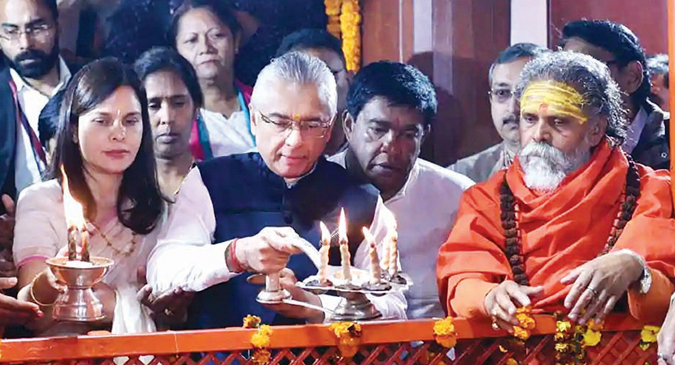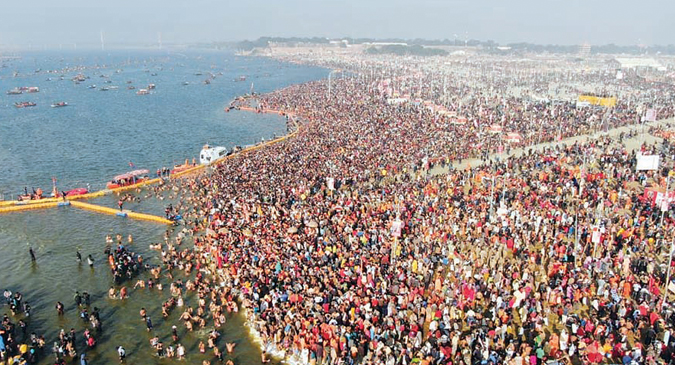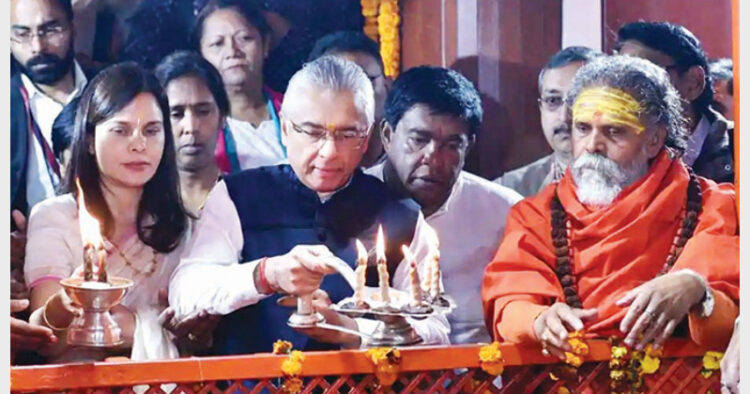This year the 55-day long grand Kumbh in Prayagraj witnessed around 3000 special guests—people of Indian origin and settled ‘foreigners’ and the other NRIs
Dravya-yajñ?s tapo-yajñ? yoga-yajñ?s tath?pare
sw?dhy?ya-jñ?na-yajñ??h cha yatayah san?hita-vrat?h
—Bhagavad Gita, Chapter 4, Verse 28
(Some perform sacrifice with material possessions; some offer sacrifice in the shape of austerities, others sacrifice through the practice of Yoga; while some striving souls, observing austere vows, perform sacrifice in the shape of wisdom through the study of sacred texts.)

Mauritius PM Pravind Jugnauth along with his wife offering prayers at Bade Hanuman temple, Prayagraj
The spirit of the above quote from Bhagavad Gita prevails very strongly at the Kumbh in Prayagraj. This year’s grand 55-day long ceremony had around 3000 special guests—all overseas Indians—some of them people of Indian origin and settled ‘foreigners’ and others NRIs. The visit was organised by the Ministry of External Affairs as part of the 15th Pravasi Bharatiya Divas celebrations. The visiting delegates showed much enthusiasm during their four-hour long journey from Varanasi to Prayagraj raising ‘Har Har Gange’ slogans at various places. Local people stood on both sides of the road between Mirzapur and Prayagraj waving hands to welcome the overseas visitors and also took snaps and recorded the moments on their smart phones. “It is like welcoming of Baraati,” said an enthusiastic US-based radio programmer H Karishma—who originally hails from Madhya Pradesh.
The NRIs were taken to ancient Akshayvat and Saraswati Koop to offer puja besides the Triveni Sangam for holy dip. “Regularity of this celebration and holy dip at the Sangam is continuing since ancient times and is unique in more ways than one,” Amar Kumar Pandey, a local resident, said.
Awareness camps
Shuttling between Akharas generally on foot and at times in buses put up by the organisers, Shantidevi Paudiyal says she speaks to other devotees and common pilgrims about the need to promote environmental awareness and better hygiene and such issues. “The Kumbh Mela festival everywhere in Ujjain or in Prayagraj offers a good occasion to share the concerns about the need to protect rivers, other water bodies and the need for improved hygiene and better waste management,” Shantidevi (52) told Organiser. Hailing from Dangri sector of mid-western region of Nepal, the ‘Sanyasini’—woman seer—is in Prayagraj for the Kumbh Mela. A widow, whose husband died in a road accident along Kakarbhitta-Pani Tanki—Nepal-West Bengal border—when she was just 22—Shantidevi moves around from Akharas (temporary camps of devotees) and also talks about her agony as her husband actually died due to alcoholism and rash driving.

Over 1.25 crore devotees took holy snan on Makar Sankranti at Prayagraj Kumbh
Many others among the Yog gurus and spiritual leaders have also joined the bandwagon on such awareness campaigns. At the venue, in some Akharas—since January 15 when the Kumbh got underway, even social workers from other religions have teamed up with Hindu leaders and Sadhus, government officials and NGO representatives to promote environmental awareness and also about the importance of making toilets.
“Many households in India still do not have proper toilets….this despite the aggressive campaign in last four and half hears,” says one such social worker Jhantu Sen from Durgapur in West Bengal.
“The symposium we organised in coordination with some Akharas from Eastern India were aimed at propagating knowledge about the importance to conserve water and keep water sources clean,” he says. Agreeing with him, Margaret Christine, a German social activist and travel writer, says, “Local Indians seemed to have shown immense interest on issues related to industrial waste going into rivers especially Ganga and streams”.
The matters related to harvest rainwater and alcoholism also figured prominently, another participant said. There is also mass level campaign across the Mela area; and some slogans read: “Gali Gali mein shor hai; Shauchaley bananey ka Jor hai” and “Ek Karya karey bhala, swachh rakhey gali mohalla”.
“Looking back, I was impressed the manner toilets both in public places and for individual families are coming up across India.
But the realisation of water conservation is less,” says Nepali Sanyasini Shantidevi. “I was not educated much but my coming to these Kumbh Melas since 2001 in Prayagraj has made me well informed. Actually lot of good thoughts are passed on during the Kumbh.
I have benefitted much and so now I do move around telling people about some problems and how they can face them,” she says. To a question, she sounds a seasoned diplomat and says, “Nepal and India are friends for ages and so every meeting I go and every holy dip I take, I pray for better and harmonious Indo-Nepal relations”. Sometimes the people from Nepal are held in suspicion even at the Kumbh festivals. But these are just few instances. In general, Kumbh is casteless and classless affairs and no one bothers either you are from Nepal or Russia,” she says.
Politics and Spirituality
But there are talks about politics too in this year’s festival. And sometime this goes the realm of contemporary politics. It is true even Sadhus and others discuss about Prime Minister Narendra Modi and issues concerning the Hindutva. Significantly enough, a Varanasi-based Muslim cloth merchant Haider Tariq sums up the paradox of the other school of thought—that is ‘secular liberals’. “A good section of enlightened Muslims including in PM Modi’s parliamentary constituency has seen the hollowness of the argument of the Congress and other parties. The Muslims want bread and butter issues solved. Then comes education….The so-called secular champions and anti-BJP forces are too eager to flaunt their politics as an exclusive accomplishment to win. But the fact of the matter is the voters will not fall for such eloquent absurdity,” says Tariq, 65.
There are many Sadhus—who while interacting with Pravasi Indians—repeatedly raised ‘pro-Ram Temple’ slogans. “I am not surprised, but I find there is a message. Whenever, I tell some Sadhus to tell something, they scream in unision—Jai Shri Ram,” says Paris-based technocrat Poritosh Ranjann Vatsya. Among the Kumbh visitors, there are some Indians—especially from states like West Bengal and also Karnataka who say—the communal polarization narratives come to help of Indian politicians who have less concern about developments. However, this contention is countered. Lalji Patel, President of Mauritius Chapter of Overseas Friends of BJP, says— “The Indians are fed up with the motivated and one sided debate on threat to secularism. BJP’s opponents have been always eloquent with post-Godhra riots of 2002 and beef eating row. But the same seculars have been silent on Gujarat having not witnessed any communal clash in last two decades”. “During last four years, there has been no major terror act except in Jammu and Kashmir,” he points out.
(The writer is a New Delhi-based commentator and travelled to Varanasi and Prayagraj to cover Pravsi Bharatiya Divas and Kumbh Mela)













Comments